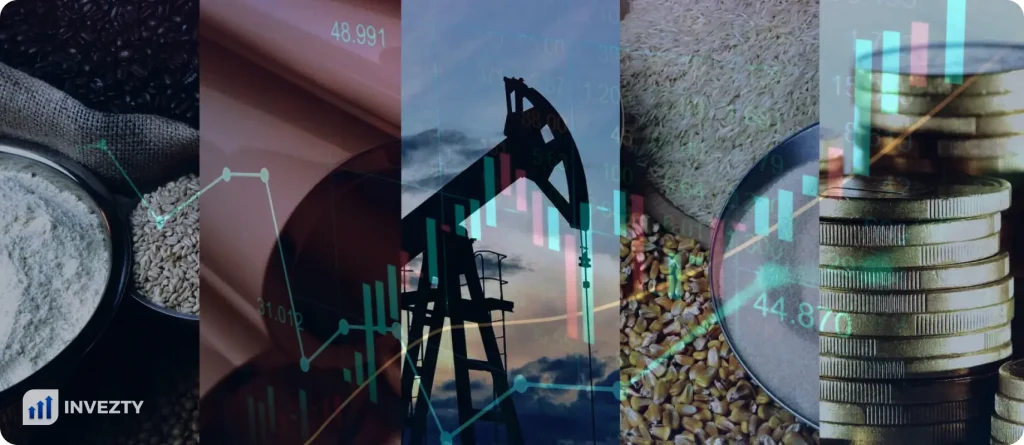Thadeus Geodfrey is a leading voice in the financial industry. You’ll appreciate the expert ease with which he does this. He deciphers the intricate link between emotions and behavior in trading and investment. With extensive experience as a senior trading writer, Thadeus imparts his knowledge and confidence to guide your trading boat. He’ll make you conquer your fears, break barriers, and capitalize on every potential opportunity. Follow his pieces and develop your knack for trading.
We may receive compensation from our partners for placement of their products or services, which helps to maintain our site. We may also receive compensation if you click on certain links posted on our site. While compensation arrangements may affect the order, position or placement of product information, it doesn’t influence our assessment of those products.
You may have heard that the War in Ukraine has led to higher grain prices or that the changing geopolitical factors in the Middle East have affected global oil prices. Commodity prices shift constantly, dictated by supply and demand patterns throughout the world economy. Like forex or stock trading, commodity trading offers profit opportunities from these changing prices through trade for years.
This guide, commodity trading for beginners, covers everything you need to know about this concept. It walks you through the basics, the step-by-step process of commodity trading online, and the risks involved. Finally, you learn why it might be a good choice for your investment portfolio.
What is Commodity Trading?

Let’s not put the cart before the horse. Before we tell you what commodity trading is, what’s a commodity?
A commodity is any raw material used in the production of finished goods. It includes agricultural products, mineral ores, and fossil fuels.
Commodities are physical goods traded on various exchanges worldwide. Supply and demand dynamics, like geopolitical events, natural disasters, and economic indicators, influence prices.
The four main types of commodities include energy, metals, agricultural, and livestock.
Energy commodities include oil, natural gas, coal, ethanol, and uranium. We also include renewable energy sources, such as solar and wind power.
Precious metals include gold, palladium, silver, and platinum, while industrial metals include iron ore, tin, copper, aluminum, and zinc.
Agriculture covers edible goods like sugar, wheat, cocoa, and grains and non-edible products like cotton, palm oil, and rubber.
And finally, livestock includes farm animals like cattle, goats, poultry, hogs, and sheep.
Now, what’s commodity trading?
It involves buying and selling raw materials or primary agricultural products and speculating on a commodity’s future value.
Commodity trading dates back to ancient trade, which laid the foundation for modern investing.
How Commodity Trading Works
There are different ways to trade commodities, and it happens in two places, namely:
- The physical market
Traders and investors buy or sell goods for immediate delivery. As a trader, you actually take a commodity, whether it’s gold bars, coins, or a herd of live cattle, and bet the prices will rise for you to sell.
Because many factors influence the prices of these commodities, commodity trading is highly volatile, making it a potentially lucrative market.
- The commodities derivative market
Traders and investors buy or sell futures financial products – futures, forwards, and options contracts – based on various commodities.
In the derivatives market, commodity trading occurs through a contract for difference (CFD). So, CFDs are at the center of how commodity trading works.
You may be wondering what a CFD is.
A CFD is an agreement to complete a transaction at a set price and time. It specifies the amount of a commodity (like oil, wheat, or gold), the set price to buy or sell, and the future date.
There are three types of CFDs: cash, futures, and spot commodities. Cash commodity CFDs involve tangible products delivered for payment, while futures CFDs set a predefined price for future transactions. Spot commodity CFDs, on the other hand, are based on the current quote for immediate purchase, payment, and delivery.
With CFDs, you don’t get the ownership of the underlying asset. Instead, they allow you to trade a “futures contract” based on the asset’s real-time price changes.
As a trader, you open (buy) positions if you expect the price to shoot and sell positions if you foresee a price drop. You can either go long or short. Going long means you’ve agreed to buy the commodity, while if you go short, you’ve decided to sell the commodity.
The goal is to profit from supply and demand trends. So, you can either be a speculator or a hedger. A speculator aims to profit from price changes by either buying low and selling high or selling high and buying low. On the other hand, hedgers use futures contracts to secure prices and protect themselves from price changes.
To learn commodity trading includes understanding how to use leverage. Leverage allows you to control large amounts of commodities with relatively little money. In literal terms, you use borrowed funds to trade more commodities than what would be available from your cash balance alone. But leverage is a proverbial sword; it can lead to huge profits and significant losses.
Commodity Trading Online: Step-by-step Guide
First, choose a market like oil, precious metals, or agriculture to start trading commodities. Consider going long (buy) or short (sell) based on market trends. Manage your risk using stop-loss and take-profit orders to limit losses and secure profits. Once you’ve set these orders, open your position and monitor the market by analyzing technical and fundamental aspects. Here’s a step-by-step guide to getting started:
As you are doing now, learning the basics is a crucial step in your future as a commodity trader. It helps you build a strong foundation. You can also read books, attend webinars, and follow financial news to expand your understanding of the commodity market further.
How to learn commodity trading begins with deciding on a broker. We always advise traders to choose a broker with a user-friendly platform, competitive fees, excellent customer support, and one that abides by Financial Conduct Authority guidelines or any other recognised regulator.
With a reputable broker at your disposal, open a trading account. But first, don’t rush to deposit funds. Use the broker demo account to practice trading with virtual money before risking your money.
As you use a demo account, develop strategies, create a budget, and have a well-defined trading plan ready, including your trading goals, risk tolerance, and entry and exit strategies.
Each commodity market has its unique features. The popular ones include oil, precious metals like gold and silver, and agricultural products such as wheat and soy. Keep in mind, though, that precious metals like gold and silver usually retain value, while oil markets are very unpredictable due to multiple factors, among them geopolitics.
Once you know your market, conduct the market analysis and decide on your entry and exit points. After analyzing and establishing your points to go long and short, use the commodity trading online platform tools and features to execute your trades and place your orders. These orders will help you mitigate risks and manage your trades.
You should monitor your positions and adjust your strategy as the market changes. But you shouldn’t do this haphazardly. Track your trades and have a rationale behind each decision and its outcomes. This review helps you identify patterns and adjust your strategies as your trading skills improve.
Commodity Trading Risks

Since the commodities derivative market has considerable risks, you spread your risk through diversification, adding different asset classes to your portfolios. Some of the risks involved include:
- Market Volatility: Commodity prices respond to various factors, including weather conditions, geopolitical factors, and even economic data releases.
- Leverage Risks: As stated earlier, leverage enhances your chances to profit and increases the risk of substantial losses. You need risk management tactics to trade on a margin.
- Liquidity Risk: Commodities with lower trading volumes may be challenging to trade since entering or exiting positions at desired prices is difficult.
- Counterparty Risk: In rare cases, parties in a futures contract default on their obligation. However, regulated exchanges have measures in place to mitigate this risk.
Why Commodity Trading?

Here are the top reasons why you should consider commodity trading:
- Simplified Trading: With various trading tools, modern commodity trading has become easier and accessible to all.
- Portfolio Diversification: Adding commodities to your investment portfolio helps reduce your overall risk. You are spreading your funds across different products. Besides, commodities are not related to the traditional asset classes like stocks and bonds.
- Inflation Hedge: Commodities, such as gold, protect the value of your investment against inflation, especially during high inflation periods.
- High Leverage: Commodity derivatives, like futures contracts, allow you to trade with more capital than you can afford, allowing you to control more assets with a fraction of the total value.
FAQs
First, choose a broker, open a trading account, deposit funds, and start trading via the platform.
The amount you need depends on the commodity and broker you choose and perhaps your strategy. Some brokers ask for a minimum deposit in your account that could be over $100. But for all intents and purposes, you can start trading with as little as $100.
To calculate profit or loss, subtract the total cost from the total revenue. The cost of purchasing the commodity includes the fees charged. A positive result means profit, while a negative result means loss.
Yes, traders can make profits with skill, research, and market knowledge. Go long if you believe prices will rise and short when you expect prices to fall.
The best commodity to trade depends on your trading goals. Popular options include gold, crude oil, base metals, and agricultural products. Gold and silver are suitable for protecting your investment against inflation risk, while crude oil is best for volatile markets. But day traders prefer oil futures.
Conclusion
At face value, commodity trading may appear confusing for beginners. But with the proper knowledge and approach, it can be rewarding. Now that you’ve some basics and know how it works, follow a structured approach to trading commodity online confidently. Remember to educate yourself continuously, have a good trading plan, and manage your risks. With persistence and discipline, you’ll be surprised by how much you can achieve with trading online.
